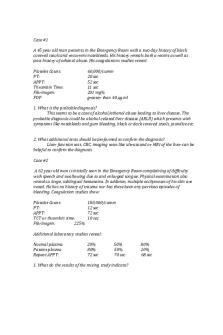Case Study, Chapter 48, Drugs Affecting Blood Coagulation PDF

| Title | Case Study, Chapter 48, Drugs Affecting Blood Coagulation |
|---|---|
| Course | Growth and development |
| Institution | Capscare Academy for Health Care Education |
| Pages | 2 |
| File Size | 110.9 KB |
| File Type | |
| Total Downloads | 64 |
| Total Views | 172 |
Summary
Pharmacology...
Description
Beene Gregg Case Study, Chapter 48, Drugs Affecting Blood Coagulation
A nursing student is reviewing notes on drugs that affect blood coagulation. The drugs that affect blood coagulation involve a complex process that involves vasoconstriction, platelet clumping or aggregation, and a cascade of clotting factors produced in the liver that eventually react to break down fibrogen into insoluble fibrin threads. The nursing student prepares a medication card for anticoagulants and drugs used to control bleeding. (Learning Objectives 2, 4, and 5)
a. What are the therapeutic actions and most common adverse reactions for aspirin, heparin, and urokinase? Ans: Aspirin - Actions: Inhibits platelet aggregation by inhibiting platelet synthesis of thromboxane A2 - Adverse effects: Acute aspirin toxicity with hyperpnea, possibly leading to fever, coma, and cardiovascular collapse; nausea; dyspepsia; heartburn; epigastric discomfort; GI bleeding; occult blood loss; dizziness; tinnitus; difficulty hearing; anaphylactoid reaction Heparin - Actions: Inhibits thrombus and clot production by blocking the conversion of prothrombin to thrombin and fibrinogen to fibrin -Adverse effects: Loss of hair, bruising, chills, fever, osteoporosis, suppression of renal function (with long-term use). Urokinase - Actions: Converts endogenous plasminogen to plasmin, which breaks down fibrin clots, fibrinogen, and other plasma proteins; lyses thrombi and emboli -Adverse effects: Headache, angioneurotic edema, hypotension, skin rash, bleeding, breathing difficulties, bronchospasm, pain, fever, anaphylactic shock b. What are the indications and pharmacokinetics for antihemophilic factor and aminocaproic acid? Ans:
-Antihemophilic factor human, also known as Coagulation Factor VIII or Anti-Hemophilic Factor (AHF), is a non-recombinant, lyophilized concentrate of coagulation factor VIII, an endogenous protein and essential component of the coagulation cascade. Antihemophilic factor is manufactured with reduced amounts of von Willebrand Factor antigen (VWF:Ag) and purified from extraneous plasma-derived protein by affinity chromatography. The small amount of VWF:Ag is used to purify factor VIII complex and then removed from the final preparation. The final purified concentrate contains albumin as a stabilizer. -The human antihemophilic factor is indicated for the cases of hemophilia A, also known as classical hemophilia for the prevention and control of hemorrhagic episodes.12 If surgery is needed in patients with hemophilia a there is a need of correction of the clotting abnormality. In this cases, the human antihemophilic factor may be administered followed by intermittent maintenance doses.11 The hemophilia A is characterized by the deficiency of the coagulation factor VIII that results in prolonged blood flow after injury or surgery as well as recurrent bleeding. c. What are the key nursing implementation considerations for patients receiving antihemophilic agents? Ans:
History. For patients in whom hemophilia is suspected, inquire about the history of hemorrhage disproportionate to trauma, history of spontaneous hemorrhage, bleeding disorders in the family, and concomitant illness (especially those associated with acquired hemophilia, such as chronic inflammatory disorders, autoimmune diseases, hematologic malignancies, and allergic drug reactions).
Physical examination. Assess for joint swelling and ability to move affected limb; Assess for limited ROM, contractures, and bony changes in the joints when bleeding has stopped. Appropriate monitoring is needed to manage active bleeding and to monitor and manage any allergic reactions that may develop during the infusion.
Pharmacology Amy Morrison Karch 2016- https://www.drugbank.ca/drugs/DB13192...
Similar Free PDFs

Coagulation drugs
- 6 Pages

Blood Case Study
- 3 Pages

Drugs Affecting the Endocrine System
- 11 Pages

Coagulation Case Studies
- 9 Pages

Note 48 - study guide
- 4 Pages

Blood - study
- 4 Pages

Chapter 48 notes - Harvill
- 4 Pages

Blood Bank case study with solution
- 16 Pages

Chapter 48: Nursing
- 4 Pages

Chapter 48 Practice Quiz
- 3 Pages
Popular Institutions
- Tinajero National High School - Annex
- Politeknik Caltex Riau
- Yokohama City University
- SGT University
- University of Al-Qadisiyah
- Divine Word College of Vigan
- Techniek College Rotterdam
- Universidade de Santiago
- Universiti Teknologi MARA Cawangan Johor Kampus Pasir Gudang
- Poltekkes Kemenkes Yogyakarta
- Baguio City National High School
- Colegio san marcos
- preparatoria uno
- Centro de Bachillerato Tecnológico Industrial y de Servicios No. 107
- Dalian Maritime University
- Quang Trung Secondary School
- Colegio Tecnológico en Informática
- Corporación Regional de Educación Superior
- Grupo CEDVA
- Dar Al Uloom University
- Centro de Estudios Preuniversitarios de la Universidad Nacional de Ingeniería
- 上智大学
- Aakash International School, Nuna Majara
- San Felipe Neri Catholic School
- Kang Chiao International School - New Taipei City
- Misamis Occidental National High School
- Institución Educativa Escuela Normal Juan Ladrilleros
- Kolehiyo ng Pantukan
- Batanes State College
- Instituto Continental
- Sekolah Menengah Kejuruan Kesehatan Kaltara (Tarakan)
- Colegio de La Inmaculada Concepcion - Cebu





